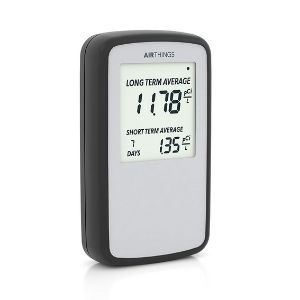There’s nothing like home sweet home. But pollutants from leftover cooking, allergens, dander, and other debris may make the air inside less than sweet.
The good news is cleaning the air in your home doesn’t just help your allergies, it may also help reduce airborne pathogens like the coronavirus.1
With so many people staying home, outdoor air pollution has decreased. During the first three weeks of lockdown, some of the world’s most polluted cities saw a 60% decrease in outdoor air pollution from the previous year.2
We’ve collected a few basic tips for improving the indoor air quality in your home during the COVID-19 pandemic and for years to come.
How to improve your home’s indoor air quality
1. Clean regularly
Cleaning your room isn’t just a good habit your mom taught you. Regularly cleaning your home can minimize dirt, dander, and indoor particles that can make you sick or cause allergies.
Here are a few simple things you can do to fight indoor air pollution.
Dust, sweep, and vacuum
Keep your floors and surfaces clean in your home by dusting, sweeping, and vacuuming regularly. If you have pets, dander can collect even faster and leave your family and guests sniffling and sneezing.
Use a vacuum cleaner with a HEPA filter that will capture and reduce debris collected in rugs, carpets, and floors. HEPA, or High Efficiency Particulate Air, filters can trap 99.97% of particles that are 0.3 microns (for reference, that’s smaller than a red blood cell).3
The more tiny particles you can remove from the air in your home, the cleaner the air will be.
Wash your linens and sheets
Dust mites, dead skin cells, and all kinds of icky stuff can hide in your bedsheets. Washing your linens, curtains, and other fabric throughout your house can keep them fresh and free of debris.
Aim for washing temperatures of 130°F and up.4 You can also find dust mite-proof pillow cases and bedding that can make the job easier.
Store shoes carefully
Tracking dirt in the house can add to air pollutants in your carpets and rugs. Store your shoes in a closet or on a rack where you can keep the dirt contained.
Then wipe the shoe rack down and vacuum the space at least once a month to keep the area clean.
Remove old food
There’s no need to hang on to old produce or any perishable food past its prime. Mold growing in your fridge or cabinets can affect the air in your kitchen and the rest of your home.
The good news is, you can prevent food waste by planning your meals ahead, eating out less, or buying groceries in smaller portions.
2. Let in fresh air
Proper ventilation is a big part of maintaining good air quality inside your house. It pushes out pollutants and “bad” air and brings in fresh air.
Check your vents
If you have central air and heating, be sure to check the ventilation throughout your home.
Change the HVAC filters inside and wipe down the vents every three months to keep dust from collecting and spreading through your home. And clean the air ducts every five years.
You can also add fans to rooms throughout your home to keep the air inside moving. Just be sure to clean them. Ceiling fans and standing fans are a favorite habitat of dust bunnies.
Open a window or use the screen door
Let your house breathe. According to the EPA, you can reduce indoor air pollutants by increasing the amount of outdoor air coming inside.5
Use an air purifier
Air purifiers help boost air circulation throughout your house.
If you have multiple pets or severe allergies, adding an air purifier to your clean air arsenal can help all year round.
Air purifiers can clean the air in one or multiple rooms, depending on the type you choose. Start your search by checking out our reviews on the best air purifiers.
3. Minimize indoor pollutants
There are a variety of indoor pollutants that can affect the air quality in your home. Some come from us, like secondhand smoke. Others, like radon, may be naturally occurring. Luckily, there are ways to reduce these dangerous particles.
Avoid aerosols
You’ve probably heard that aerosols are bad for the environment. So why should you use them in your home? For products like hair sprays and cleaners, look for alternatives that don’t use an aerosol application.
Use ventilation when cooking
One 2017 study showed that a gas oven can release “250 micrograms of fine particulate per cubic meter of air,” a concentration comparable to the air in the world’s most polluted cities.6
Before you start cooking, clean off your stove or range to avoid releasing old baked-on particles into the air. Oil, dust, and old food residue may release into the air when heated.
If you have a range hood, use it any time you use the stove or oven. If not, use the back burners closest to the range vents to suck up any particles released during your time cooking.
Test for radon
Radon is the colorless, odorless byproduct of decaying radioactive matter. It may sound like something out of a comic book, but it’s a very real threat to homes across the country.
Radon can leak into your home through cracks in the foundation. Prolonged exposure can even lead to lung cancer. Test your home for radon to improve the air quality in your home and make it safer for years to come.
These tests identify the problem rather than solve them. But knowing about potential radon poisoning in your home can give you a head start on treatment and prevent the problem further.
Use carbon monoxide detectors
Carbon monoxide is more than a pollutant—it’s a killer. This colorless, odorless gas is released by burning carbon fuel like those from your stove or home gas line.
Be sure to maintain your carbon monoxide detector with fresh batteries and update it every ten years.
CO detectors don’t improve indoor air quality on their own, but they’ll alert you to any problems like gas leaks in your home and pass the baton to you.
4. Form good habits
Maintaining good air quality in your home requires regular work. So it’s best to start by forming a few habits that keep the air clean in your home.
Avoid smoking or vaping indoors
While smoking tobacco and vaping have been banned indoors in most public areas, they can still pose problems in homes.
Tobacco smoke can cause health issues in children and adults—think respiratory problems, ear infections, and heart disease.7 Secondhand smoke can stay on walls, windows, and surfaces throughout the house long after the tobacco is gone.
If you’re a smoker or use an electronic cigarette, be sure to go outside before you use it. That will keep the air cleaner inside for you and everyone you live with.
Monitor your air quality
Watching the air quality in your home will help you stay on top of your cleaning and treatment. An air quality monitor can check the humidity, particulate matter, and volatile organic compounds (VOC) in the air in your home.
Close the lid when you flush
Ever heard of toilet flumes? Flushing the toilet can release waste particles into the air in your bathroom (ew).8 It’s gross, but true. To avoid this, get in the habit of closing the lid before you flush the toilet.
Choose beeswax candles
If you want to mask any odors in the bathroom, consider using a beeswax candle. They emit less smoke than standard candles and can make your bathroom smell much better after visits.
FAQ
What causes bad air quality indoors?
A number of things can contribute to poor indoor air quality (like dust, allergens, and smoke). But what solidifies poor indoor air quality is bad circulation and build up of particles.
How can I check the air quality inside?
You can find air quality monitors for your home that will show you things like humidity, volatile organic compounds, temperature, and an overall air quality index.
Why is air quality so important?
The air you breathe circulates throughout your body. So it isn’t just your lungs, nose, and throat that feel it. Although the obvious effects of poor air quality include asthma, bronchitis, and emphysema, it can also affect your circulatory system and heart health.9
Sources
- Environmental Protection Agency, “Indoor Air in Homes and Coronavirus (COVID-19),” Accessed August 4, 2020.
- Helen Regan, CNN, “Air Pollution Falls By Unprecedented Levels In Major Global Cities During Coronavirus Lockdown,” April 2020. Accessed August 13, 2020.
- Coway, “What Is a HEPA filter?,” Accessed August 5, 2020.
- Harvard Women’s Health Watch, “Easy Ways You Can Improve Indoor Air Quality,” March 2018. Accessed August 5, 2020.
- Environmental Protection Agency, “Improving Indoor Air Quality,” Accessed August 4, 2020.
- Emily Anthes, Scientific American, “Coronavirus Lockdowns May Raise Exposure to Indoor Air Pollution,” June 2020. Accessed August 4, 2020.
- Centers for Disease Control, “Health Effects of Secondhand Smoke,” February 2020. Accessed August 13, 2020.
- Caroline Picard, Good Housekeeping, “Please, for the Love of God, Close the Toilet Lid When You Flush,” August 2018. Accessed August 5, 2020.
- Spare the Air, “Overall Health Effects,” Accessed August 5, 2020.
The post How to Improve Air Quality in Your Home appeared first on SafeWise.
from Blog – SafeWise https://ift.tt/3jh4csj
via IFTTT



No comments:
Post a Comment